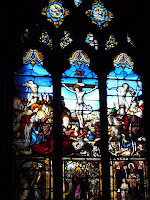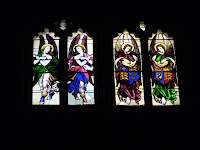Saturday 1 August
After much anticipation, we were finally off to Germany. We were picked up from Westgate Street not long after 7am on a cool, rainy morning. Not a promising start to August. Not to worry. Our pick up vehicle was a mini van, which was very, very cosy – we couldn't sit on 2 seats. No one could!. It did lots of stops to pick up other people who were doing other tours with the same tour company. Thankfully about 10.30 we transferred to a full sized coach for the last part of the trip to Dover. We crawled through along the M25 (apparently usual) through lots of green and farmland. We were then delayed by an accident, which prevented 3 coaches from being on the same ferry sailing as us. We had to wait in Calais for 1 ½ hours for them to catch us up. The services at Calais are not the most exciting place to hang around on a Saturday afternoon.
Because of the delays we didn't arrive at our first hotel in the Netherlands until 11pm. We were absolutely shattered. The hotel, though, was quite nice. The room was HUGE, with the oddest bathroom we've ever seen – it was right in the middle of the room with all glass walls.


Quite, um, interesting.
We were pretty tired, but on the way to the hotel some of the things we saw were lots, and lots of wind turbines (and there were hundreds more to come over the rest of the week), likewise the fields of wheat we saw being harvested – on some days it felt as though half of Europe is covered in wheat. And Kathy saw (while Matt snoozed) a white cat in a field of white cows. Cool.
Sunday
The day started with a yummy continental breakfast – meats, cheese, tomato, cucumber and bread. Mmmmm. Today we headed in to Germany to start the tour proper. It was a misty, rainy start to the day, which was a little disappointing. We went to the Commonwealth Cemetery at Rheinburg.



Matt at Rheinburg

Kathy at Rheinburg
Like all Commonwealth Cemeteries it's beautifully maintained, and similarly not often visited.

There are so many, so I guess that people just visit the most popular ones. A whole aircrew from the Dambusters raid is buried at Rheinburg. Most of the men buried there were airmen.

RAAF headstone from Rheinburg
It was as sombre as Tyne Cott, but had a different feeling because it was misty and rainy; it was also smaller – a few hundred. They were from all corners of the Commonwealth. While we were there the weather started to improve, and we left as the weather started to clear and the sun began to come out.
Some of the other things Kathy saw were roe deer in a field, brown goats (like the ones in Heidi), lots of wind farms.
Today we also went to the Mohne Dam.

It's a beautiful spot, and would have been a challenge for the airmen. Much of the surrounding area is a national reserve and full of walking and cycling tracks.

Matt near the Mohne Dam

Detail on the Mohne Dam
 Matt on the Mohne Dam
Matt on the Mohne Dam

Kathy on the Mohne Dam

One of the 'pillars' on the Mohne Dam used to guide the planes in
According to our tour guide there is still a lot ill feeling amongst the older residents in the nearby town towards the British because of the bombing raid. You can't see where the dam was breached because of the way in which it was repaired – likewise the village which is opposite the spillway.

While we were there we had an opportunity to grab a bite to eat – currywurst. It was, um, interesting.
After the Mohne we went to the Ede Dam. It's very small,

One of the towers on the Ede Dam

Part of the spill-way at the Ede Dam
and is in a very tight series of valleys

The valley the Ede Dam is in
– it would have been even more challenging getting in and out in a Lancaster. Challenging.

Castle, used by the Dambusters as a navigation point
Again, it's a beauty spot and surrounded by nature reserves.

Kathy at the Ede Dam
It was quite interesting to see where the breach spot was – but fairly obvious as the Germans had filled it in very quickly. There had also been a festival of some sort on there. Perhaps some sort of harvest festival, because there were a 'bride' and 'groom' made out of hay bales, and an ompahpah band – oh, and a beer tent. So thirsty....
It was another long drive to the hotel for the night. There was a lot of traffic and castles – one was good, one not so good. On our way from West to East we passed one of the last remaining border posts. We also passed the memorial to the Buchenwald concentration camp. As we headed eastwards it became quite obvious when we started to get deeper in to the old East Germany. The buildings became more run-down looking, and there were many blocks of worker apartments – row upon row of them. Many are now brightly painted, but they used to be grey concrete. Not the most exciting places to live – even now.
Because we were right on the edge of town there was no-where to eat apart from the hotel. This was to be a feature of the other places we stayed. Not to worry, we still had lovely steaks with heaps of veges and some nice crisp German beers.
Monday
We had an early start today, because there was quite a drive ahead of us to get to Colditz. Because it's summer, it's roadworks season – so lots of detours. We didn't mind too much, because we got to see lots of smaller towns, not just highway. There were a lot of house proud people living in those towns. Beautiful front gardens full of flowers, vegetables and fruit-trees – mostly apples or pears. We also saw many large, buy European standards, fields of wheat or maize – all the old collective farms.
The coach finally got to Colditz, and drove up to a square near the Castle.

Colditz township
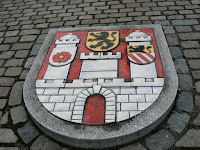
Town symbol for Colditz


Narrow pathway up to Colditz Castle
Matt was a little disappointed to start with, because the Castle is painted bright white, and he was expecting it to be a large grey hulk on its own on the top of the hill. But it's not – and there are houses quite close to the Castle, too.





Photos of the main courtyard at Colditz Castle
We weren't able to wander around the Castle on our own, but had a guide instead. He was OK, but didn't really tell us much more than what was on the information plaques around the place. Or was unable to tell tales that Matt didn't already know. There's been a castle on the site since the 11th century, and it's been owned by various earls, barons & electors since. Previous castles have been burnt down a couple of times, before being rebuilt in its current incarnation during the 16th and 17th centuries, with 19th century additions. What we didn't expect to see was that the main courtyard is sloped, not flat, like it is in the movies. It's pretty amazing what the prisoners did – the sheer tenacity and desperation involved. We saw a tunnel dug out by French prisoners,

which came out first in the chapel,

The French tunnel in the chapel

Door in to the Chapel from the main courtyard

Detail from the chapel doorway

Inside the chapel

Ceiling in the chapel
then outside the walls.

We also saw the rooms which were 'solitary', which were good to see, as were various paintings

and diary extracts, and costumes prisoners used for escape attempts.

What Kathy didn't know is that Charles Upham was incarcerated there. The main gates,

Detail over the main gate at Colditz
and the gates the prisoners entered by were both amazing. At the end of the trip, Matt was pretty impressed. Some of the other people on the tour were disappointed that the Castle is not all a museum. The local government is turning part of it in to a music school, which I think is a really good use of the property.

The outside of the Castle
Back on to the coach after quickly grabbing some food, then off to Dresden. Another long day in the coach (picking up a trend yet?), but we were driven through some lovely countryside. We were allowed some free time in the city, being given the option of either being dropped off by the opera house or to stay with the coach and go so a shopping centre somewhere.

Matt in Dresden
We took the option of being dropped off by the opera house. We were glad that we did. Dresden is beautiful,



and sad.

Many of the surviving buildings have not been cleaned off, but it's not all fire-storm damage – apparently the East Germans used brown coal for heating, etc.

This is a very polluting type of coal, so things are pretty messy. Many buildings are blackened still, but the gold leaf which has been put on some of the buildings makes a stunning contrast of the bright gold against the dense black.
Matt reckons that some of it was a message to the British “you may be able to bomb us in to the ashes of the earth, but you cannot defeat us”. We wandered around around,

Kathy in Dresden near the river

Matt at the same place

The communist era is never far behind
and took lots of photos.


Part of a fresco in downtown Dresden of the rulers of the local area

Kathy by the fresco of rulers
We went to the top cupola of a church which had been rebuilt after the war. The Germans had used both new and old blocks, so that the outside of the church looks spotty. When we got to the top we were greeted by fantastic views out over Dresden,


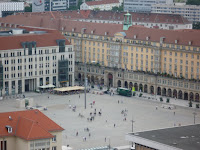
over to the hills and surrounding countryside.


Brilliant.
We walked back to the opera house to meet the coach, but were delayed by 30 minutes after we had to wait for one of the older gentlemen on the tour to be found (again a theme for the week, waiting for Frank – he's a bit absent minded). Once we got to the hotel, and learnt to our dismay that we were 30 minutes by tram from Dresden, we waited for our bags to turn up, got changed, and went to find somewhere to eat. Trusting the advice of the hotel reception staff we headed off to a little restaurant nearby. We weren't feeling all that confident, as we bumped in to some others from the tour who said that nothing except a kebab shop and a Chinese takeaway were open. We found the restaurant – and it was open! The menu was all in German (lesson – need to learn some German before we go to Austria for Xmas), so ordering was all guess work. It ended up with Matt ordering rabbit, and Kathy ordering duck. Each dish came with mystery dumplings, which were nice with the rich sauces. We had good food, good beer, and a good time. And good slivovitz. On the way back to the hotel Kathy heard, then we both saw lots of bats! Everything just came together nicely. When we got back to the hotel the small bar at the hotel was full, so we went back to the room and finished off the whisky we'd brought with us as we sat and watched people walking past on the street.
Tuesday
Today we had the luxury of a later start, at 9.30am. What Kathy had assumed from the information from the tour company would be a walking tour of Dresden ended up being a coach tour. Not particularly impressed. We went to the ruins of a church right on the edge of the 'destruction zone' (where the fire-storm had spread to), which is now being used as a youth centre.

The ruins of the nave of the church

Detail from the top of a column


We climbed up to the top of the old bell tower for the view (not as good as yesterday).

View from the top of the belltower in to the ruined nave
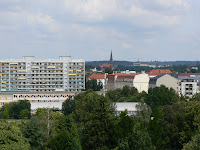
View over Dresden, including communist-era apartments

We then were driven to look at 3 stately homes which overlook the River Elbe



and the flood plain where thousands suffocated as they tried to escape the fire-storm Too much blimmin' time on the coach!!!

Matt trying not to laugh at something silly said by our tour guide

an incredibly bright gold statue of a past ruler of Dresden

Funky art in Dresden - there was a lot of this around the city to brighten up buildings
We also learnt about the '60 year rule', where houses whose owners 'disappeared' curing WW2 must be left untouched for 60 years in case their owner or their descendants turn up to claim them. After this time if they are still unclaimed the Government sells off the house. It explains why there were so many apparently abandoned buildings.

Believe it or not, this is a synagogue
We were dropped off at a mall near a railway station (oh joy, a strip mall) for lunch. We also got cash and tried to find a new memory card for our large camera, without much luck. Hope it's not obsolete already!
After lunch we were driven up in to the hills to go and see some rock formations – the Bastei. They were pretty good, especially as many of the biggest complainers were not on this optional trip. The Bastei are large limestone stacks which have eroded in to columns – some look like the Gherkin in London, others remind us of being in the Blue Mountains.





There's a really pretty village at the bottom of the hill in a river valley to look at as well.


It was good to get out for a walk, even if it was for only an hour or so. Back to Dresden, via a supermarket to pick up essentials for lunch for tomorrow (and some schnapps). Kathy saw a real working Trabant! We went back to the same restaurant, but it wasn't quite as good as yesterday, because Matt was feeling a bit blue – the trip hasn't quite been what we had expected. Because of that, and that we were tired we went back to our hotel room, had some of the schnapps, and read our books before having an early-ish night.
Wednesday
Today we went in to Poland, to go to the camp where The Great Escape had been from – Stalag Luft III. There was a lot of graffiti beside the roadway – more motorway driving. The countryside changed again as we got closer to the Polish border, with more trees and smaller fields. Poland is so much poorer than the former East Germany. On the trip there we saw a field of hops, and another field which had wild deer in it.
The first stop was the site of Stalag VIII C, which was a PoW Camp which held mainly Poles and Russians. The site now has a museum to the various PoWs, replicas of a hut

and guard tower,

and a replica of part of the tunnel also known as Harry.

There is a really heart-wrenching memorial there to the hundreds of Poles who died.


The replica huts contain all sorts of information about the prisoners and the camps – and of course the various escape attempts.

Mock-up of a PoW room

Sand from the site of where 'Dick' was dug
After lunch we went off to Stalag Luft III. We were impressed that so much still remained – we didn't expect to see anything but trees,

but there were a lot of concrete slabs still,

Matt in ze kooler
and the pit from the theatre, the floors of the infirmary,

bits of a water store,

and the piles for the huts. Where Harry was has been marked,


and you can see where the end of the tunnel was – it's marked by a memorial stone.


The whole trip was very cool. We saw lots of beautiful wildflowers and insects – including bright blue dungbeetles.
One stop was a complete waste of time. We went to the railway station where the prisoners were off-loaded.

What the...?!?!? That's 20 minutes of our lives we won't get back. How thrilling – a Polish railway station.... We then, more importantly, stopped at a memorial for the 50 escapees who were killed by the Germans. But we had to listen to the tour guide going on, and on, and on, and on about the 50. Oh well.
On the way back in to Germany we saw lots of beautiful gardens. We saw an eagle while we were stuck in traffic, as it went soaring over fields looking for prey.
When we got to the hotel in Berlin there was a massive queue at the reception, so we had a beer to wait. We found somewhere to eat, and Matt had a grilled meat feast (sausage and all sorts) with beer, of course, and Kathy had yummy cold pickled herrings. We had a yummy herbal schnapps to finish. A good end to the day.
Thursday
Today we had too many things to do, but not enough time in which to do them. We started the day with, quite naturally, a coach tour. First stop was a prison. We were being driven down through industrial areas, thinking – what are we being taken to? We had no idea. The prison was amazing – it's still a working prison, but it's where many dissenting Germans were interred, tortured and in some instances killed.

Entry to the prison museum

The name of the prison

It was a side of wartime Germany we weren't aware of. It would have been good to have spent more time there, to read all the stories of some of the people interred there, but no, we got rushed along.
Next stop was the Olympic Stadium.

Matt, at the Berlin Olympic Stadium
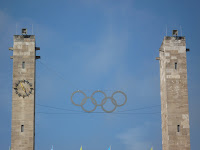
The Olympic rings
We couldn't go in, partly because 'we don't have the time' but also because it was closed to the public to prepare for an international athletics competition in September. We were taken to a tall golden statue in a round about, and to an American museum,

Matt, with one of the planes used in the Berlin Airlift
which told the story of the Berlin airlift (again, time was rushed).

Guardtower, with a bit of the Wall

Kathy, with a bit of the Wall

Does this need explanation?
We also were taken to another railway station

– this time one where the Berlin Jews were loaded up to go off to the concentration camps.

View back along the now defunct platform

Memorial to the transported Jews
Next stop was Kaiser Wilhelm's church (or what was left of it)

the ruins of Kaiser Wilhelm I's cathedral, from where we had lunch


Shell damage on the cathedral ruins

Incredible frescoes in what is left of the vestibule of the cathedral

and its incredible replacement.

The interior of the new cathedral - all beautiful, glowing blue glass
Today's cemetery was the Berlin Commonwealth Cemetery.


This cemetery served both WWII and Cold War deaths.

This cemetery had whole flight crew buried together, including a lot of crew who died on 2 December 1943 (key night in the Battle of Berlin). It was an oasis of green in the area it's in.

During the day we were driven through all 4 sectors that Berlin had been divided in to, and so we saw a lot more bits of the Wall than we expected to see

– including some parts which were being re-painted in preparation for the anniversary of the fall of the wall.

Artist at work
This particular part of the wall was in East Berlin, and the East Berliners were allowed to paint it after Reunification.



This reminded Kathy of someone...

Kathy at the Wall
One funny story from the day. The former Spandau Prison (where Rudolf Hess was imprisoned) was turned in to a NAAFI (military supermarket) by the British forces. Apparently the squaddies used to call is Hesco's.
We did think that Berlin, especially compared to Dresden, is looking rather unkempt – both eastern and western Berlin (well, what we saw). We saw lots of statues of bears – which is the symbol of Berlin.

Matt also ended the day happier – we found a memory card which fits the big camera!! Yay!

Us, on the coach
At lunchtime we had yummy fresh pretzels. Mmmmmmm.......
At the hotel Matt made friends with a drunken Swede, who told him about a massive beer festival – again, and again. After dinner at the hotel (on the edges of town again – who woulda thought?) we headed back out again. We were driven past the sight of the beer festival!

Matt, with one foot in the east, one in the west. Check out what's in the background...
We also went to a Checkpoint Charlie mockup and museum,
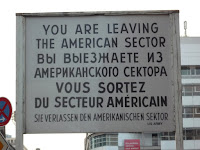

which commemorates those affected by the Wall, and people who tried to escape, or made successful escapes, to the West. Rushed, again. We could have easily spend several hours there. It was amazing – some of the escape stories were incredible. The risks people put themselves to to help others to have a better life.
And there we saw both a Bugatti Veyron (did you know it costs at least £100,000 – or so the guide says. Hmm, won't get much change from £1,000,000 buddy) and a Lamborghini Mercialago. And Kathy saw a Lotus.
Next stop was the Reichstag

(or Bundestag, as it's now known).

German flag on top of the Bundestag
Matt got very annoyed at the tour guide, who insisted on rushing people on so that we couldn't enjoy (or take photos of) the view of the city in the sunset while the light was just right for taking photos.

Sunset over Berlin
This was typical of him (the tour guide, not Matt). That aside, it was a beautiful sunset – we just wanted to make the most of it. There is a glass dome on top of the Bundestag


The interior of the dome
which is just pretty good, and it creates lovely views over the city.



The reconstruction work continues, 60 years later

From there we went to the Brandenburg Gate, via a memorial to those politicians who were killed by the Nazi regime,

and to people who died going over the wall nearby.

The Brandenburg Gate is everything you think it is.


It looks beautiful all lit up.

From there we walked to a holocaust memorial. You can walk all around and through it. It's made of blocks of granite of different heights, with the tallest blocks in the middle. We felt quite hemmed in, as it's very imposing and disorientating. Because of the dark it was difficult to see where we were going – I can only imagine how difficult it was for some of the more elderly members of the tour party.

Last stop of the evening was allegedly Hitler's Bunker. All we could see in the dark was a carpark. It was 10.30pm. So this is the spot where Hitler's Bunker was – the one where he either shot himself in the head or took a cyanide pill. We stood there for 30 minutes. In the dark!! Listening to bull about what the KGB did, or didn't, do to Hitler's body. AAARRRRGGGGHHHH!!!!! Give us that time back!!!!!
The tour guide really was annoying a lot of people over the past few days. And we've still got more of him to come!!
Friday
Today we drove from one side of Germany to the other. 9 friggin' hours on the bus. And the air-conditioning wasn't working properly – so it was hot and stuffy on the coach. Fantastic. And, to make matters even better at one stop we were ordered on to the bus, only to sit and wait for the drivers for 20 hot and stuffy minutes. Thanks guys.
We didn't really see much today, except for wind farms,

Wind farm in a wheat field
wheat fields being harvested (why do all the farmers seem to have green coloured machinery?) and birds of prey.

...and an old observation post
When we finally got to the Netherlands and to our hotel (at the edge of town, again.) we discovered that it backs on to a lake which was full of geese and ducks,

who came right up to the window of our hotel room. We were able to open windows up and sit outside the restaurant, until the midges came out. Because we were so far out of town we had to eat at the restaurant, which was expensive (€9 for 2 beers) but the food was pretty good. Kathy had monkfish and Matt had sole.
The day was far too long, with far too many hours on the coach. It would have been better if the day had been broken up part way through with an overnight stop. Live and learn.
Saturday
Yet another long day today, but at least we were able to get out at various stages and see things. First stop was a memorial to the airborne assault for Operation Market Garden.


Next stop was in Arnhem to see the bridge of A Bridge Too Far fame,



Ah, those wacky Netherlanders...
via the Arnhem Oosterbeek war cemetery


and a nearby civilian cemetery where a surgeon who worked with allied forces during the war was buried.
The most emotional stop of the whole trip was, for some reason, the Reichswald Forest Commonwealth cemetery.

The main reason for the stop was to see some of the Dambuster crews which never made it home,

but we were more interested in seeing the large number of Aussie and Kiwi aircrew. It was probably that, the fine weather, and the heart-rending dedications on many of the headstones.

So we visited the guys from 617 squadron,

plus those of our countrymen we could find.

Kathy, paying her respects to one of the fallen Kiwis
At this cemetery there were also a lot of medics, chaplains, and other auxiliary personnel, for some reason. We both cried a lot.
After lunch we visited our last war cemetery of the trip (and we've now had our fill of European theatre war cemeteries!). At this cemetery personnel from all 3 forces

plus the merchant navy are buried,

which was quite nice.
Another WTF moment when we stopped to see where Guy Gibson crashed. Why? It's in the middle of an industrial park, right outside some poor guys warehouse! Several of the streets in the area are named after Gibson, his navigator Warwick, and RAF WWII era planes. The better stop was the cemetery where they were buried by the locals – to spite the Germans. It's not a Commonwealth War Grave, but the 2 burial plots they are in are maintained by the Commonwealth War Graves Commission in conjunction with the local parish.

Thank goodness it's the last day tomorrow – our tour guide is really grating on our nerves....
Before dinner we were sitting in the bar at the hotel (again having to eat at the hotel) we were sitting and talking about places we still wanted to visit in Europe. Matt suggested Rome, but we've both have been there. Matt said “I still can't get the smell of cat urine out of my eyes”. Que?!? Well, he was on his second Belgian beer....

Look familiar? Matt's reward for not losing his temper with the tour guide

Kathy's reward

And our second one...
We had an OK dinner, but again it was expensive. One of the most frustrating things about this trip has been that all our hotels have been on the outside of various towns and cities, so we've been mostly limited to eating dinner at our hotels. It's been expensive, and we haven't been able to get out and about and experience local food and drinks. A very important lesson about these types of tours.
Sunday
Today is our last day on the road. Thank goodness. It was a shortish drive to get to the ferry terminal, but with 1 stop at a chocolate factory. It was frequented by British tour groups, of course, so things were expensive, and the chocolates weren't as good as those we had in Bruges – but we still bought some (sucker!). The best bit about it was waiting outside – there was a chicken wandering around the carpark, quite unconcerned by the people and the coaches.
A very, very long wait (2 or 3 hours) at Calais for the other coaches to arrive, and for our luggage to be transferred to the feeder coach to go home. After lunch we all got on to the ferry, through immigration, and back to Wales.
It was a very long trip, and we're glad to be home, but it was a mostly good trip. Would we do it again? No. The days were too long, the hotels were too inconveniently placed, and we were rushed through the interesting things but dawdled through the boring things. But we're glad we've done it, as it would have been difficult to do otherwise. We've dabbled in coach tours, but it's not for us.
























